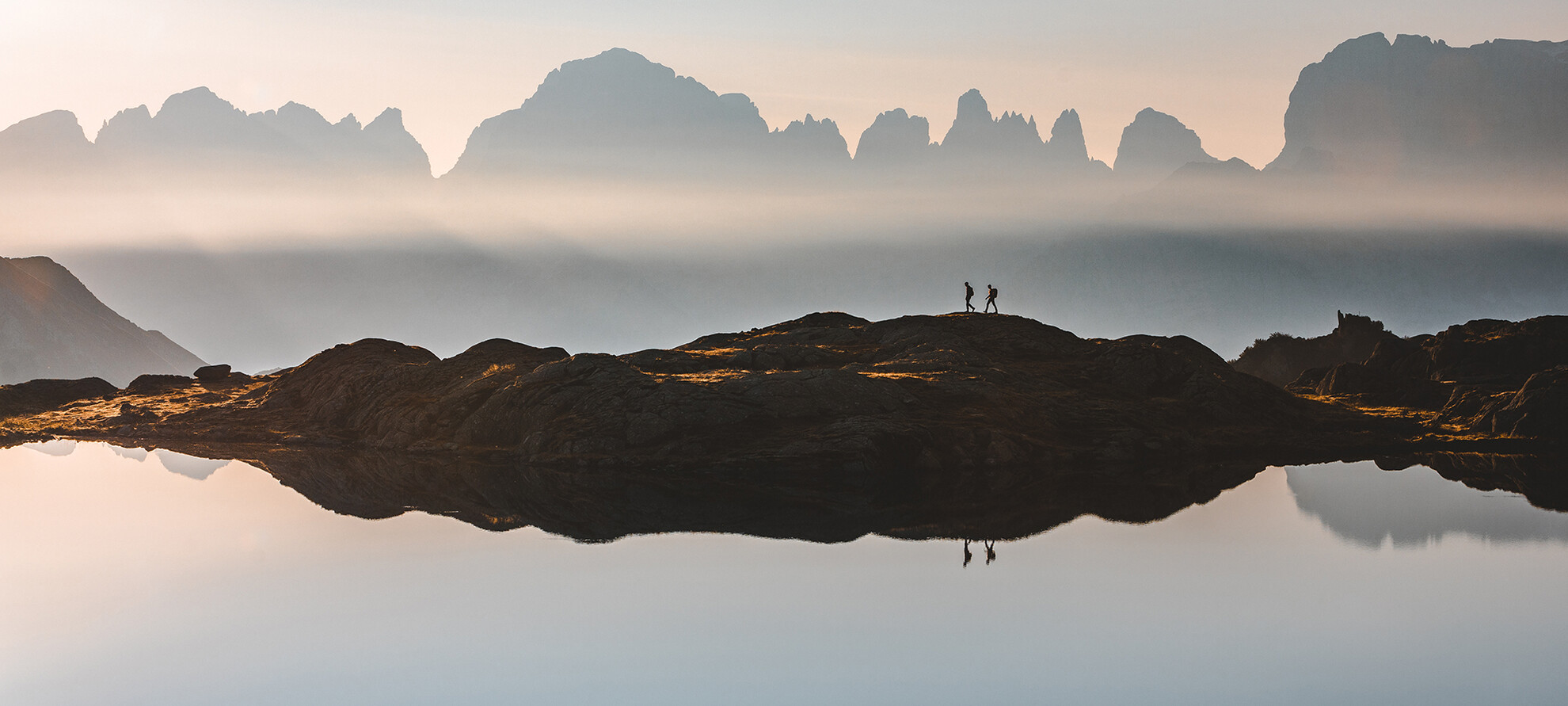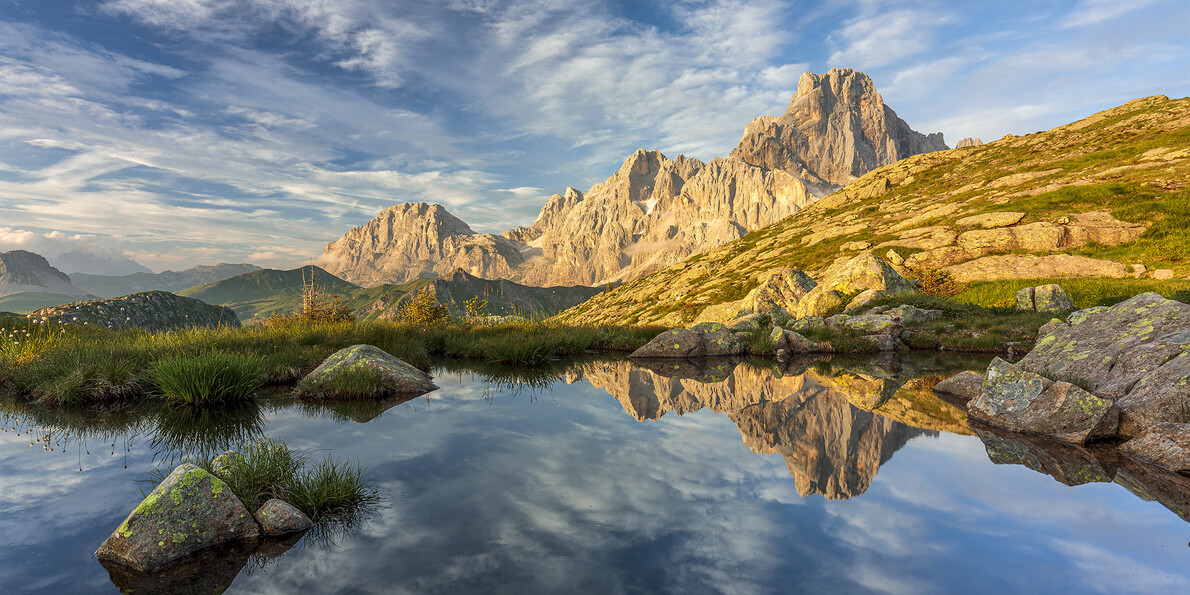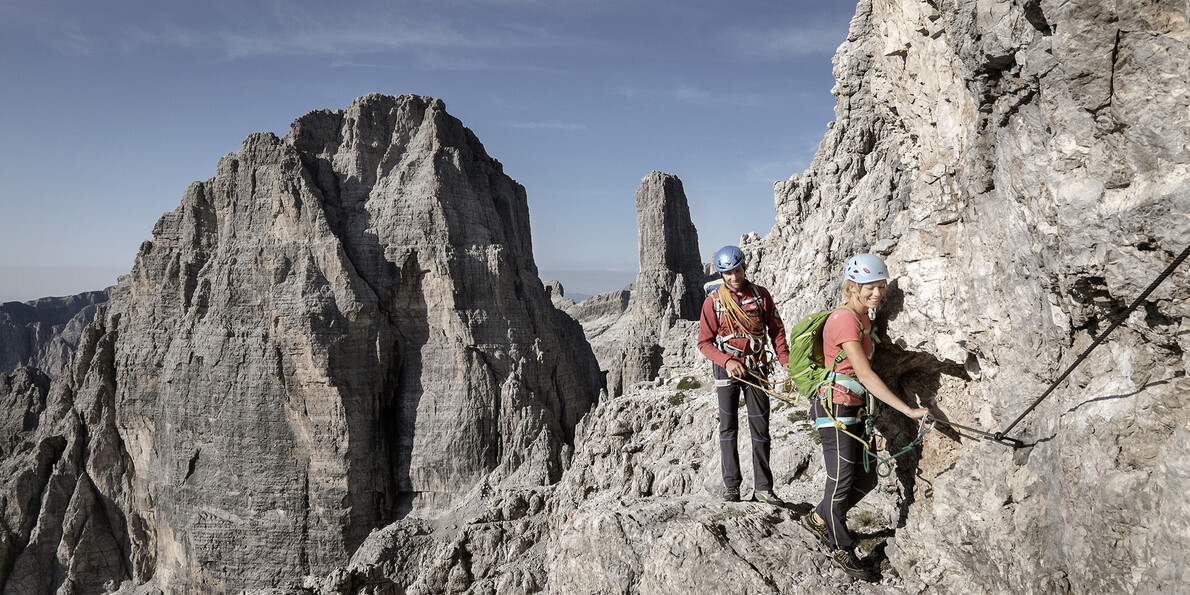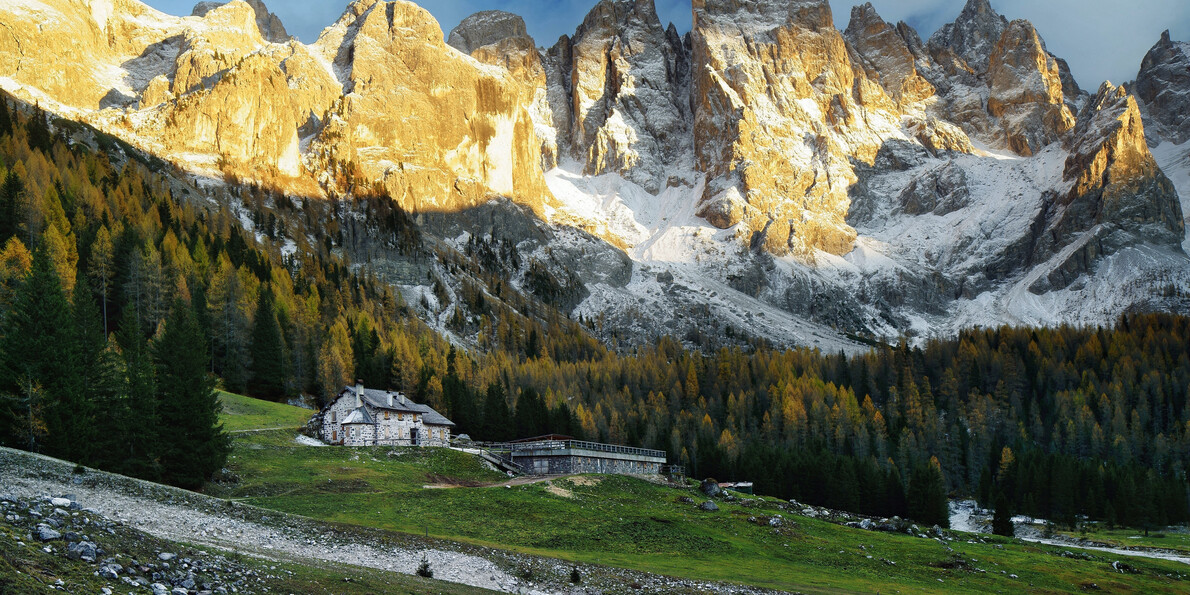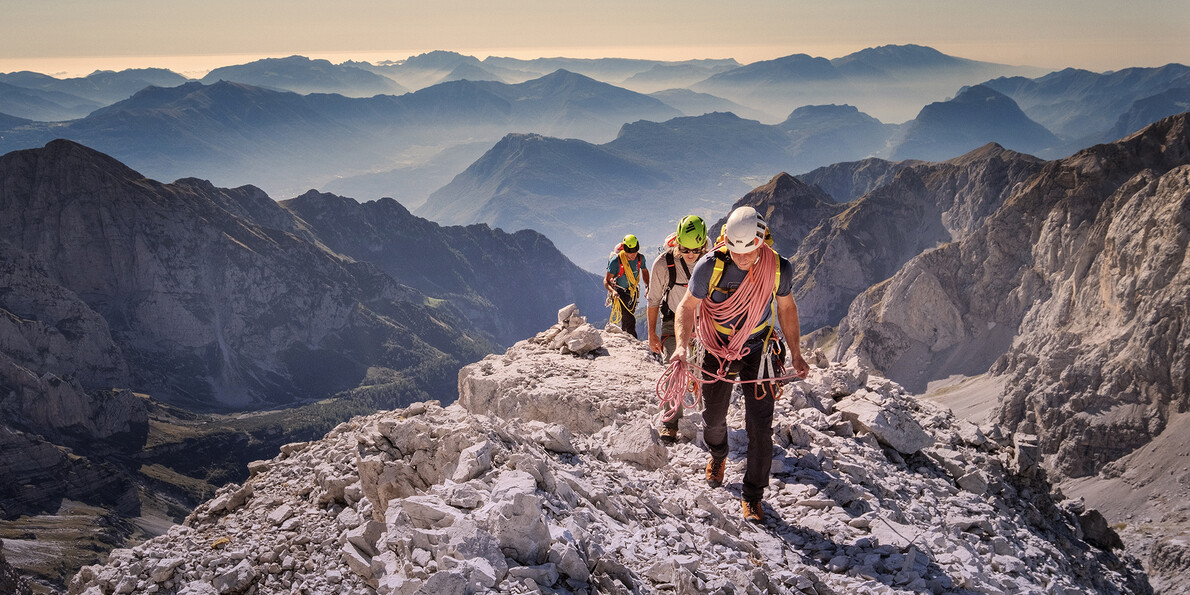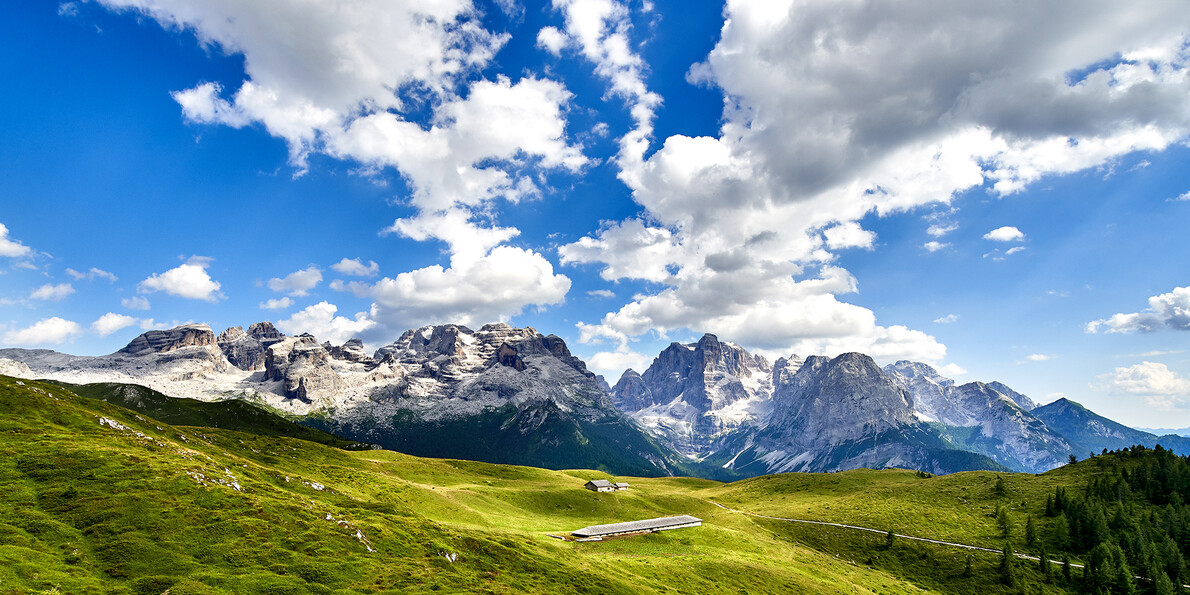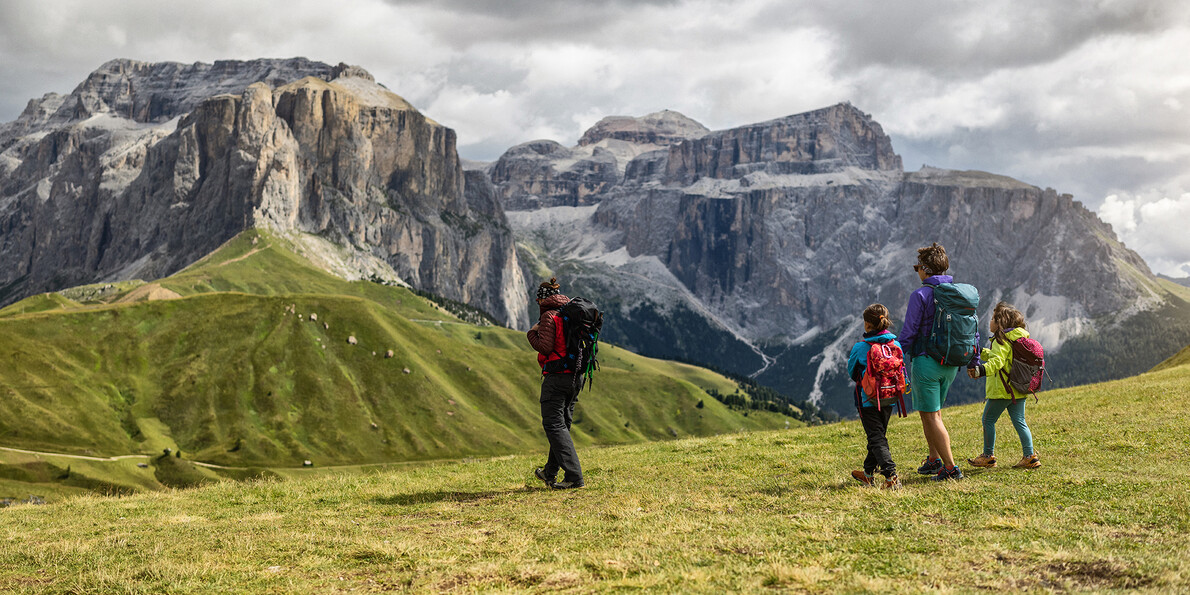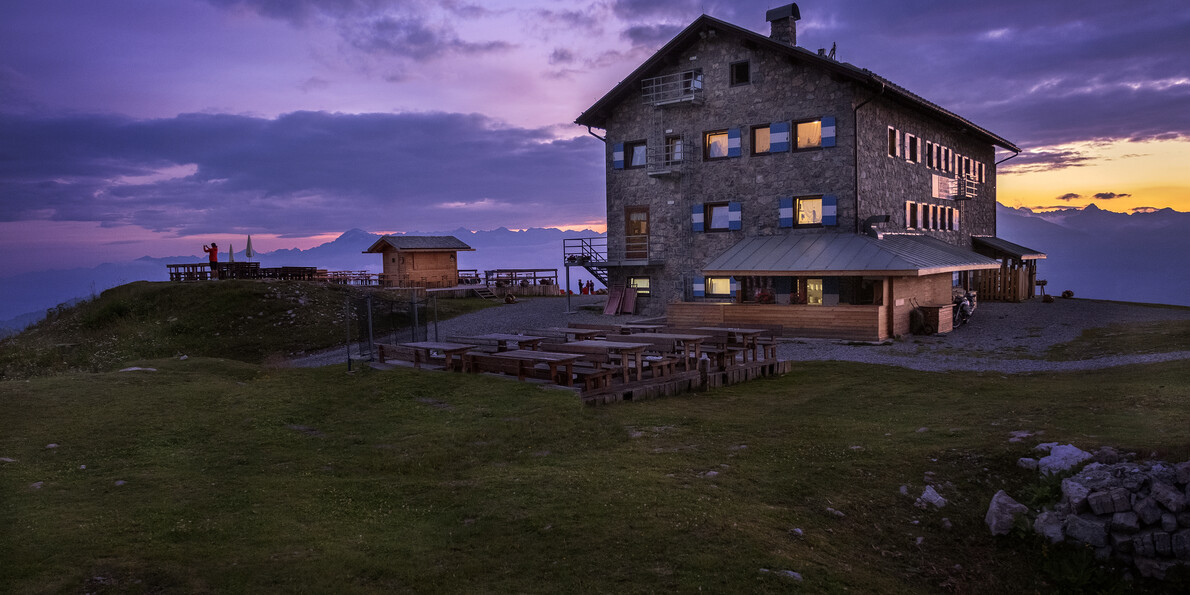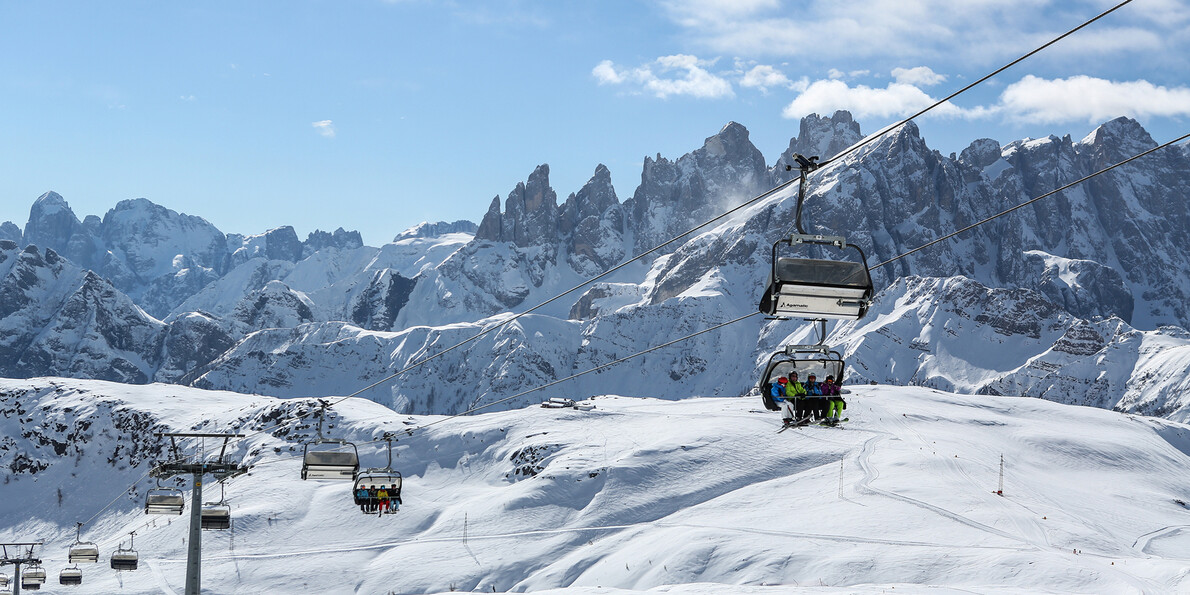Dolomites: 10 questions and answers to get to know the Pale Mountains
Everything you need to know about the Dolomites, a UNESCO World Heritage site
The Dolomites spark curiosity for their light colour, for the shapes of their peaks and for that rosy glow which, in the morning and evening, transforms the outline of the mountains. If you’re starting to discover this area, you probably already have a few questions in mind.
We’ve collected 10 questions and 10 answers about the Dolomites, to offer you a clear and complete guide. The goal is not only to give you practical information, but to help you build a sharper image of these mountains, so that you can feel a little more familiar with them even before you arrive.
#1 - What are the Dolomites?
The Dolomites are a series of mountain groups in the Eastern Italian Alps, formed millions of years ago by the accumulation of shells, corals and algae in ancient shallow seas. Over time, these sediments turned into rock. Then, the movement of the Earth’s crust plates lifted these masses of stone, raising them well above 3,000 metres.
The feature that makes them so special is dolomite rock, which largely composes them. It is made of a double carbonate of calcium and magnesium, studied at the end of the 18th century by the French naturalist Déodat de Dolomieu, from whom both the mineral and the mountains take their name.
This pale rock gives rise to:
- vertical walls and imposing bastions that rise above pastures and forests
- spires, towers and pinnacles that create a distinctive skyline
- a special relationship with light, which explains the phenomenon called enrosadira
When you look at them from the valley, you realise how different they are from other mountain ranges: not only in height, but in shape and in the way their colour changes throughout the day.
#2 - In which city are the Dolomites?
If you want to understand where the Dolomites are, think of north-eastern Italy. They don’t belong to a single city or a single valley, but extend across several provinces and regions.
Simply put, you can say that the Dolomites cover areas of the provinces of Trento, Belluno, Verona, Vicenza, Udine and Pordenone. In this wide area you’ll find places whose names you may already know, such as Madonna di Campiglio, San Martino di Castrozza, Canazei, along with many other mountain villages.
From a geographical point of view, the Dolomite area is delimited by:
- to the north, the course of the Rienza river and the Pusteria Valley (Val Pusteria)
- to the south, the Cismon Valley (Val Cismon) and the Fiemme Valley (Val di Fiemme)
- to the west, the Adige Valley (Valle dell’Adige)
- to the east, the Piave river and the Cadore area
Within these boundaries you’ll find several mountain systems: it is therefore not a single mountain, but a mosaic of massifs, plateaus, valleys and alpine passes connected to one another.
#3 - Why are they considered a World Heritage Site?
On 26 June 2009, the Dolomites were recognised by UNESCO as a Natural World Heritage Site. This decision came after years of studies and discussions, and concerns nine mountain systems distributed across various Italian provinces.
The recognition is based on two main aspects:
-
Geological value
The Dolomites are considered a sort of great stone book that tells the history of the Earth in a very clear way. In their layers you can read the traces of ancient tropical seas, coral reefs and submerged islands, later uplifted and sculpted by glaciers, wind and water. For scholars and geology enthusiasts, these mountains are a point of reference. -
Landscape and natural value
Dolomite groups feature strong contrasts: rocky bastions that rise sharply from conifer forests, suspended plateaus, deep gorges, glaciers and snowfields that survive at relatively low elevations. The shapes of the peaks are very varied and recognisable, creating scenery that changes with the seasons, light and weather.
The nine areas recognised by UNESCO include, among others, systems such as the Marmolada, the Pale di San Martino, the Catinaccio with the Latemar, the Brenta Dolomites, the Friulian Dolomites. Each area has its own characteristics, but all share the same rocky structure and the same relationship with light.
When you walk at the foot of these mountains, you realise that their fame does not come only from tourism: it is supported by decades of research, protection and knowledge.
#4 - Where can I see them in Trentino?
Trentino is home to some of the most famous and accessible Dolomite groups, each with its own character. If you want to explore the Dolomites starting from here, you can focus on four main areas.
Latemar and Catinaccio
They are located in the north-eastern part of Trentino, between the Val di Fassa and the Val di Fiemme. The Catinaccio is famous for its walls that glow at sunset and for the valleys that lead to historic mountain huts. The Latemar stands out for its towers reflected in small alpine lakes and for trails that cross forests and grassy slopes.
Marmolada
This is the highest peak in the Dolomites, with its main summit exceeding 3,300 metres. From Trentino you can reach it via the Val di Fassa. On one of its sides there is still a glacier, which tells a lot about the recent history of climate and mountaineering.
Pale di San Martino
Further east, but more to the south, you’ll find the Pale di San Martino, within the Paneveggio – Pale di San Martino Nature Park (Parco Naturale Paneveggio – Pale di San Martino). Here large suspended rocky plateaus, vertical walls and valleys such as the Val Venegia dominate the landscape, offering wide views over the peaks.
Brenta Dolomites
They are the only large Dolomite group to the west of the Adige river, and lie entirely in Trentino, inside the Adamello Brenta Nature Park (Parco Naturale Adamello Brenta). Their walls overlook valleys such as Val Rendena, the Giudicarie, the Val di Non, and the area around Molveno and Paganella. Here the rock forms steeples and chains of peaks that have shaped the history of mountaineering.
Observing these groups on different days, under different lights and in different seasons helps you understand how much the word “Dolomites” contains many different worlds.
#5 - How do I get to the Dolomites?
Reaching the Dolomites in Trentino is easier than it may seem. You can do it by public transport, private car, bike or on foot, depending on the area you choose. Here are some practical access points to the main Dolomite groups in Trentino.
Latemar group
You can arrive on foot via trails starting from Pampeago, just above Tesero in the Val di Fiemme, or use the lifts from Predazzo up to Rifugio Passo Feudo (2,175 m). From here, the hike to Rifugio Torre di Pisa begins, a true gateway to the Latemar’s rocky amphitheatre.
Catinaccio
From the centre of Vigo di Fassa (San Giovanni di Fassa), a modern cable car takes you in just a few minutes to the Ciampedìe Belvedere, at about 2,000 metres, and to the hut of the same name. From here several hiking routes set off. Another option is to start from the hamlet of Pera, where the chairlifts Vajolet 1 and Vajolet 2 lead to Pian Pecei. In about 20 minutes on foot you can reach Gardeccia, a key junction for various excursions. From Pian Pecei a third chairlift also runs up to Ciampedìe.
Marmolada
You can start from Canazei and follow the road towards Passo Fedaia. Once at the pass, at around 2,057 metres, the silhouette of the Marmolada is reflected in the waters of the Fedaia reservoir. From here you get a good sense of the size of the glacier and the walls above.
Pale di San Martino
One option is to enter the Val Venegia, which offers a gradual approach to the walls. Another is to go up the Val Canali, not far from Fiera di Primiero. From San Martino di Castrozza you can take the Colverde gondola, which brings you to the foot of the Pale and to the hut of the same name, or choose the Rosetta cable car, which takes you directly up to the Pale Plateau (Altopiano delle Pale), a starting point for many hikes and for reaching Rifugio Pedrotti alla Rosetta.
Dolomiti di Brenta
There are four main access points:
- Val Rendena: with lifts leading up to Grostè or on foot from Vallesinella, not far from Madonna di Campiglio.
- Giudicarie valleys (Valli Giudicarie): from the Val d’Ambiez, above San Lorenzo in Banale, towards Rifugio Agostini, or from the Val d’Algone up to Rifugio Dodici Apostoli, overlooking the Adamello and Presanella groups.
- Val di Non: from Rifugio Peller above Cles, or through the Val di Tovel, with its lake and trails climbing towards the Brenta walls.
- Molveno and Paganella area: from the Pradel plateau, just above Molveno, you can reach Rifugio Tommaso Pedrotti on foot or by lift, right in the heart of the group.
Whether you choose the lift or the forest path, the transition from valley to rock always comes with a moment of surprise: a bend, a clearing, a change of slope that suddenly opens up the view over the peaks.
#6 - Is it cold in the Dolomites?
At higher elevations, the temperature is often lower than in the plains or valley towns. In the Dolomites of Trentino you are usually above 1,500 metres, and with cable cars you can easily reach 2,000 metres and beyond.
In the winter months, snowfall is frequent and can last a long time. For those who love skiing, this means well-covered slopes and white landscapes for many weeks. For those who walk, it means moving in an environment that requires attention, proper equipment and good preparation.
In summer, the Dolomites offer cooler temperatures than the lowlands. Days in the sun can be warm, but the air remains drier and in the evening you often need an extra layer, especially above 1,800 metres. Afternoon thunderstorms are not uncommon, particularly in the warmest months.
The mountain climate is a constant reminder that weather here changes quickly. For this reason, even if you set off under a clear sky, it’s always a good idea to bring a warm layer and rain protection.
#7 - What is the right clothing?
Choosing the right clothing for the Dolomites is not a detail. It means putting your safety and comfort first, so you can enjoy your day without worries.
In winter, bring:
- winter boots with good grip, preferably with ankle support
- a warm, waterproof jacket, with mid-layers you can add or remove depending on the temperature
- waterproof or windproof trousers
- hat, gloves, neck warmer and thermal socks
- possibly snowshoes, if you plan to walk on fresh snow
If you come to ski, you can use your own equipment or rent it locally: in the Dolomite resorts of Trentino you’ll find plenty of rental shops.
In summer, even if it’s hot in the valley, conditions change quickly at higher altitudes. A basic kit may include:
- technical long trousers, also useful to protect your legs from wind, rocks and vegetation
- trekking shoes with a sculpted sole
- a breathable technical T-shirt
- a cap or hat for sun protection
- a long-sleeved layer in your backpack
- a windproof and waterproof jacket, especially in spring and autumn
In all seasons it’s important to carry a backpack with water, some snacks, sunscreen and sunglasses. In the mountains the sun is stronger, and reflection on snow or rock increases exposure.
Dressing in layers, with light but functional garments, allows you to adapt to weather changes without having to give up your hike.
#8 - Can I sleep in the Dolomites?
Yes, and doing so changes the way you experience the mountains. Sleeping in the Dolomites means seeing the peaks in different lights, listening to the sounds of the night at altitude and waking up with the first glow behind the ridges.
The most common option is mountain huts (rifugi). They are located in strategic positions along trails or near passes, and offer:
- beds in rooms or dormitories
- meal service
- information about routes and trail conditions
Compared to hotels, they are simpler structures, but this simplicity is part of the charm of staying there. Generally, high-altitude huts are open from the end of June to around the end of September, with variations depending on weather conditions and snow cover.
If you decide to spend the night in a hut, it’s good practice to book in advance and bring a light sleeping bag or sleeping liner. In many huts, especially those of the CAI (Italian Alpine Club), this is a rule, for reasons of hygiene and mutual respect.
Those with more experience, and who can manage navigation, weather and unexpected events on their own, can choose to sleep in a bivouac. These are small, unguarded shelters, often in very isolated locations, equipped with the bare essentials: a few bunks, a table, some chairs and little else. There is no charge to use them, and it’s quite common to share the space with other people who have arrived from different routes.
Spending at least one night at altitude helps you to slow down. The pace of the day is no longer dictated by the clock, but by the changing light and the time needed to reach the next stop.
#9 - What are the Dolomites famous for? Here's everything you can do
The Dolomites are best known for their outdoor activities, which vary according to the season. This territory invites you to move, to observe, to test yourself with effort in a gradual way, choosing the level that suits you best.
In winter, many people immediately associate them with skiing. The resorts in Trentino facing the Dolomite groups, such as Madonna di Campiglio, Canazei, San Martino di Castrozza, offer slopes of varying difficulty, connected by modern lifts. Besides alpine skiing, you can enjoy cross-country skiing, snowshoe excursions, ski mountaineering along authorised routes and accompanied by someone who knows the area well.
In the warmer months, the Dolomites become a vast network of hiking trails. There are routes suitable for those approaching the mountains for the first time, and more demanding ones for those with experience. Many trails lead to malghe (alpine farms) and huts, where you can take a break, have lunch or simply enjoy a drink while looking at the peaks.
Lifts open in summer allow you to reach higher elevations without facing major ascents, so you can save your energy for the most panoramic sections.
The Dolomites are also ideal terrain for:
- rock climbing, on historic routes and equipped crags
- via ferratas, combining trails with sections equipped with cables, ladders and rungs
- trail running, for those who love running on natural terrain
- road cycling, with passes such as Sella, Pordoi and Fedaia, which have made cycling history
- mountain biking and e-biking, on dedicated routes or in bike parks at altitude
Among the best-known itineraries is the Via delle Bocchette in the Brenta Dolomites: a series of equipped routes that wind between ledges and walls at high altitude. It is suitable only for those who don’t suffer from vertigo, are well trained and move with proper gear.
Beyond sports, the Dolomites also offer space for those simply looking for a quiet walk, a panoramic bench, a small alpine lake where you can stop in silence. Often, you don’t need much: a short trail, a stretch of forest, a vantage point from which to calmly observe the profile of the peaks.
#10 - What is enrosadira (alpenglow)?
Enrosadira is the phenomenon whereby, at dawn and dusk, the peaks of the Dolomites take on shades ranging from pink to red and even purple. The word comes from Ladin and literally means “turning pink”.
Where does this play of light come from? The explanation has to do with two elements:
- the chemical composition of dolomite, rich in double carbonate of calcium and magnesium
- the angle at which sunlight strikes the rock walls when the sun is low on the horizon
When light passes through a greater thickness of atmosphere, as at dawn or dusk, its colour composition changes and it interacts differently with the pale rock surface. The peaks then take on hues that can range from delicate pink to more intense red, before gradually fading into the blue of evening.
Enrosadira is visible at many times of the year, but in summer the phenomenon often lasts a few minutes longer thanks to the extended twilight. It never repeats in the same way: each day brings its own combination of clouds, air clarity, humidity and dust in suspension.
For centuries, mountain communities have tried to describe this phenomenon through legends.
Seeing enrosadira in person means stopping, choosing a quiet spot and waiting. It is an invitation to slow down, to accept that some things cannot be held onto: you can only be there in the moment when they happen.
